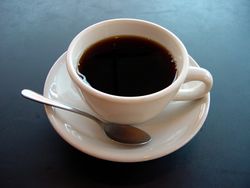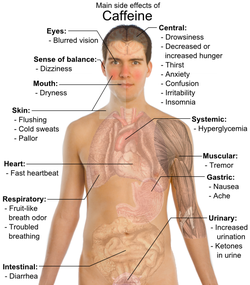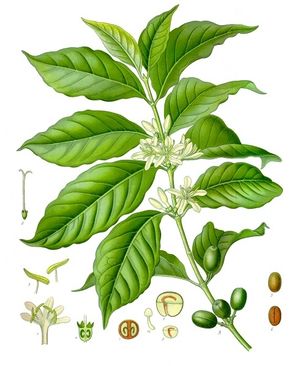القهوة الغذاء الصحي الجديد
خطأ لوا في وحدة:Effective_protection_level على السطر 63: attempt to index field 'TitleBlacklist' (a nil value).
 A cup of black coffee | |
| النوع | Hot or cold beverage |
|---|---|
| بلد المنشأ | Ethiopia |
| تاريخ الطرح | Approx. 15th century (beverage) |
| اللون | Dark brown, beige, black |
تريد مادة يمكن أن تقلل من خطر مرض السكري ، ومرض باركنسون وسرطان القولون ، و ..؟ ويمكن أن ترفع المزاج ، وتعالج الصداع؟ ويمكن أن يقلل من خطر نخر الأسنان؟
إذا كان ذلك يبدو جيدا أو صحيحا ، ففكر مرة اخرى.
البن ، ذلك الضرر الكبير الذى كنا نظنه ولكنه مما لا شك فيه مشروبا محببا ، ومجرد جعل العناوين تمهد للحذر من خطر وباء مرض آخر ، السكري من النوع 2. والخبر حقيقي ويبدو أنك سوف تشرب أكثر ، كلما كان ذلك أفضل.
الحد من مخاطر الأمراض
وبعد تحليل بيانات عن 126،000 شخص لمدة تصل الى 18 سنة ، فإن الباحثين في جامعة هارفارد وجدو أن حساب مقارنة مع لا يشارك في شراب أميركا المفضل صباحا حيث أن 1-3 فناجين من القهوة المحتوية على الكافيين يوميا يمكن أن تقلل من مخاطر الاصابة بالسكري ولكن بعد ستة أكواب أو أكثر كل يوم خفضت خطرإصابة الرجال بنسبة 54 ٪ والنساء بنسبة 30 ٪ .
على الرغم من أن العلماء أعطوا التقرير المعروف "مطلوب المزيد من الابحاث " قبل أن نوصي بالعمل الإضافي في ستاربوك على وجه التحديد لمنع مرض السكري ، والنتائج التي توصلوا إليها هي مشابهة جدا لتلك الدراسة الهولندية الأقل حظا من الدعاية. وربما الأهم ، هو آخر من مئات من الدراسات التي تشير إلى أن القهوة قد تكون نوعا من الأغذية الصحية -- وخاصة بكميات أكبر.
وفي العقود الأخيرة ، فإن بعض الدراسات التي أجريت على 19،000 فحصا لتأثير القهوة على الصحة. وبالنسبة للجزء الاكبر ، ونتائجها التى أضحت مرضية مثل الجرعة اليومية من مزيج الإفطار يخمر حديثا للاميركيين 108000000 الذين يتمتعون تقليديا بصورة روتينية صباح كل يوم -- وطوال اليوم على نحو متزايد -- طقوس. من الناحية العملية ، يشربون القهوة العادية وتشمل غالبية البالغين في الولايات المتحدة وعدد متزايد من الأطفال.
وبشكل عام ، ويظهر البحث أن القهوة هي صحية أكثر من أى وقت مضى"، كما يقول توماس DePaulis ،الحاصل على دكتوراه ، عالم أبحاث في معهد جامعة فاندربيلت لدراسات البن ، الذي يجري أبحاثه الطبية الخاصة ومسارات دراسات البن من جميع أنحاء العالم." للحصول على معظم الناس ، والقليل جدا السىء يأتي من شربه ، ولكن الكثير من العمل الجيد ".
ولنتأمل هذه الحقيقة : ما لا يقل عن ست دراسات تشير إلى أن الأشخاص الذين يتناولون القهوة بشكل منتظم ما يصل الى 80 ٪ اقل احتمالا لتطوير مرض باركنسون ، مع ثلاثة تظهر تأثيرات على أمراض بعينها بقدر ما يشرب من القهوة، وانخفاض المخاطر. أبحاث أخرى تبين أن لا مقارنة لشرب القهوة ، أو على الأقل كوبين يوميا يمكن أن تترجم إلى ما يقلل خطر الاصابة بنسبة 25 ٪ من سرطان القولون ، وهو انخفاض بنسبة 80 ٪ لخطر تليف الكبد ، وحوالي نصف من مخاطر حصى في المرارة.
يقول DePaulis :القهوة تزيح حتى بعض الأضرار الناجمة عن الرذائل الأخرى ، تشير بعض البحوث. وقال "الناس الذين يدخنون ويحتسون الكحوليات بكثافة هي أقل تعرضا لأمراض القلب وتليف الكبد عندما يستهلك بانتظام كميات كبيرة من القهوة بالمقارنة مع أولئك الذين لا يتناولون القهوة".
هناك أيضا بعض الأدلة على أن القهوة قد تساعد في السيطرة ومراقبة الأزمات لمرضى الربو حتى الهجمات الت تحدث في حال عدم توافر الدواء ،و تساعد في وقف الصداع ، وزيادة المزاج ، وحتى منع نخر الأسنان و التسوس.
Health and pharmacology

وقد ركزت الدراسات العلمية على العلاقة بين استهلاك القهوة ومجموعة من الحالات الطبية. وهى نتائج متناقضة بشأن ما إذا كان لدي القهوة أية فوائد صحية محددة ، والنتائج المتضاربة بالمثل بشأن الآثار الضارة المحتملة لتناول القهوة.[2]
الاختلافات في النتائج ، مع ذلك ، يمكن حلها جزئيا على الأقل من خلال النظر في طريقة إعداد القهوة ورقة باستخدام مرشحات ورقية لإزالة المكونات الزيتية التى تدعى diterpenes والتي توجد في القهوة غير المرشحة. نوعين من diterpenes موجودة في القهوة : kahweol وcafestol ، وكلاهما قد ارتبط بزيادة مخاطر الإصابة بأمراض القلب التاجية عن طريق رفع مستويات البروتين الدهني منخفض الكثافة (LDL) في الدم.[3]
المرشحات معدنية ، من ناحية أخرى ، لا تزبل المكونات الدهنية من القهوة.[4]
وبالإضافة إلى الاختلافات في طرق التحضير والبيانات المتضاربة بشأن حجم الحصة قد يفسر جزئيا عن الاختلافات بين الآثار المفيدة أو الضارة / لتناول القهوة.
Coffee consumption has been shown to have minimal or no impact, positive or negative, on cancer development;[5] however, researchers involved in an ongoing 22-year study by the Harvard School of Public Health state that "the overall balance of risks and benefits [of coffee consumption] are on the side of benefits."[5]
Other studies suggest coffee consumption reduces the risk of being affected by Alzheimer's disease, Parkinson's disease, heart disease, diabetes mellitus type 2, cirrhosis of the liver,[6] and gout. A longitudinal study in 2009 showed that those who consumed a moderate amount of coffee or tea (3–5 cups per day) at midlife were less likely to develop dementia and Alzheimer's disease in late-life compared with those who drank little coffee or avoided it altogether.[7] It increases the risk of acid reflux and associated diseases.[8] Most of coffee's beneficial effects against type 2 diabetes are not due to its caffeine content, as the positive effects of consumption are greater in those who drink decaffeinated coffee.[9]
References
- Allen, Stewart Lee (1999). The devil's cup : coffee, the driving force in history. Soho: Random House. ISBN 1569471746.
{{cite book}}: CS1 maint: ref duplicates default (link) - Bersten, Ian (1999). Coffee, Sex & Health: A history of anti-cofee crusaders and sexual hysteria. Sydney: Helian Books. ISBN 0-9577581-0-3.
{{cite book}}: CS1 maint: ref duplicates default (link) - Clarke, Ronald James; Macrae, R, eds. (1987). Coffee. Vol. 2: Technology. Barking, Essex: Elsevier Applied Science. ISBN 1-85166-034-8.
- various (1985). "Botanical Classification of Coffee". In Clifford MH, Wilson KC (ed.). Coffee: Botany, Biochemistry and Production of Beans and Beverage. Westport, Connecticut: AVI Publishing. ISBN 0-7099-0787-7.
- Ganchy, Sally (2009). Islam and Science, Medicine, and Technology. The Rosen Publishing Group. ISBN 1435850661.
{{cite book}}: More than one of|author=and|last1=specified (help)CS1 maint: extra punctuation (link) - Jacob, Heinrich Eduard (1998). Coffee: the epic of a commodity. Short Hills, N.J.: Burford Books. ISBN 9781580800709.
{{cite book}}: CS1 maint: ref duplicates default (link) - Kummer, Corby (August 19, 2003). The joy of coffee : the essential guide to buying, brewing, and enjoying. Boston: Houghton Mifflin. ISBN 0618302409. Retrieved January 11, 2010.
{{cite book}}: CS1 maint: ref duplicates default (link) - Metcalf, Allan A (1999). The world in so many words : a country-by-country tour of words that have shaped our language. Houghton Mifflin. ISBN 0395959209.
- Pendergrast, Mark (2001) [1999]. Uncommon Grounds: The History of Coffee and How It Transformed Our World. London: Texere. ISBN 1-58799-088-1.
{{cite book}}: CS1 maint: ref duplicates default (link) - Souza, Ricardo M (2008). Plant-Parasitic Nematodes of Coffee. シュプリンガー・ジャパン株式会社. ISBN 9781402087196.
{{cite book}}: CS1 maint: ref duplicates default (link) - Weinberg, Bennett Alan; Bealer, Bonnie K (2001). The world of caffeine : the science and culture of the world's most popular drug. New York: Routledge. ISBN 0415927226.
{{cite book}}: CS1 maint: ref duplicates default (link)
Footnotes
- ^ "Caffeine (Systemic)". MedlinePlus. May 25, 2000. Archived from the original on February 23, 2007. Retrieved January 26, 2010.
- ^ Kummer 2003
- ^ Baukje de Roos, B; Sawyer, JK; Katan, MB; Rudel, LL (August 1999). "Symposium on 'functionality of nutrient and food safety': validity of animal models for cholesterol-raising effects of coffee diterpenes in human subjects". Proceedings of the Nutrition Society. 58 (3): 551–7. PMID 10604186.
{{cite journal}}: Invalid|ref=harv(help) - ^ خطأ استشهاد: وسم
<ref>غير صحيح؛ لا نص تم توفيره للمراجع المسماةCornelis - ^ أ ب Boyles, Salynn (October 13, 2008). "Caffeine, Breast Cancer Link Minimal". WebMD. Retrieved January 26, 2010.
- ^ Klatsky, Arthur L; Morton, Cynthia; Udaltsova, Natalia; Friedman, Gary D (June 12, 2006). "Coffee, cirrhosis, and transaminase enzymes". Archives of Internal Medicine. 166 (11): 1190–5. doi:10.1001/archinte.166.11.1190. PMID 16772246. Retrieved January 26, 2010.
{{cite journal}}: Invalid|ref=harv(help) - ^ "Midlife Coffee And Tea Drinking May Protect Against Late-life Dementia". ScienceDaily. January 15, 2009. Retrieved January 26, 2010.
- ^ Gillson, Sharon (November 28, 2007). "10 Most Frequent Causes of Heartburn". About.com. Retrieved January 26, 2010.
- ^ Pereira, Mark A; Parker, Emily D; Folsom, Aaron R (2006). "Coffee consumption and risk of type 2 diabetes mellitus: an 11-year prospective study of 28 812 postmenopausal women". Archives of Internal Medicine. 166 (12): 1311–6. doi:10.1001/archinte.166.12.1311. PMID 16801515. Retrieved January 26, 2010.
{{cite journal}}: Invalid|ref=harv(help)
By Sid Kirchheimer WebMD Feature Reviewed by Michael W. Smith, MD
